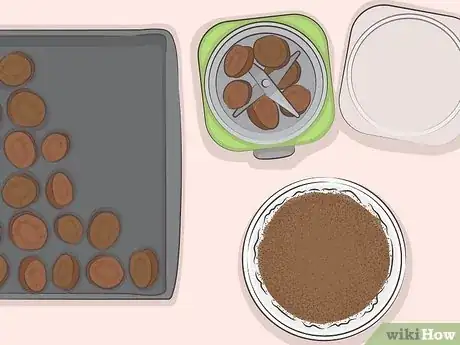This article was co-authored by Julie Brow-Polanco and by wikiHow staff writer, Jessica Gibson. Julie Brow-Polanco is a Master Herbalist & Certified Aromatherapist with more than 11 years of experience. She is an expert on natural remedies and specializes in using them to support whole-body wellness, particularly immune, digestive, nervous, and reproductive health. Julie earned a Bachelor's Degree in Psychology from Dominican University, a Master Herbalist Certification from The School of Natural Healing, and a Certificate of Aromatherapy from the Pacific Institute of Aromatherapy. Julie is a member of the American Herbalist Guild and a Certified Aromatherapist through the National Association of Holistic Aromatherapy.
There are 15 references cited in this article, which can be found at the bottom of the page.
This article has been viewed 44,439 times.
Chicory is an incredibly versatile plant with a slightly bitter taste, and there are tons of different ways to eat it. Although most people roast the root to grind for a coffee-like drink, you can also eat the leaves cooked or raw. Raw leaves add a spicy or peppery taste to salads while cooking the leaves brings out their bittersweet flavor. If you're ready to learn how to eat chicory or chicory root, keep reading for the best recipe tips and storage tricks.
Things You Should Know
- To make chicory coffee, chop chicory root and roast it. Then, grind it and brew the powder as you would coffee.
- Wash the leaves and add them to your favorite salad. The slight bitterness is great with rich foods like creamy cheese, nuts, and avocados.
- Roast or sauté whole or halved chicory leaves and serve them with creamy sauces or cheese to make a great meal or side.
Steps
Chicory Root Coffee
-
1Wash and slice the roots. Scrub them with a vegetable brush under running water until the roots are clean and place them on a cutting board. Use a sharp knife to carefully trim the ends and slice the roots into pieces that are less than 1 in (2.5 cm) in size.[3]
- You can use store bought chicory roots or forage for them, although chicory roots grow deep in compacted soil, so this can be a workout.
- Brewing chicory root coffee is a good way to help you reduce coffee consumption.
-
2Bake the chicory roots in a 350 °F (177 °C) oven for 2 hours. Spread the pieces of chicory root onto a baking sheet so they're in a single layer. Then, put them in the oven to roast until they're totally dry.[4]
- If your oven runs hot, drop the oven temperature to 200 °F (93 °C).
-
3Grind the roots into a powder. Let the roasted chicory root cool completely. Then, transfer the pieces to a coffee grinder, spice grinder, or food processor. Blend the pieces into a powder that's about the same consistency as coffee.[5]
-
4Brew the chicory powder as a coffee replacement. Chicory powder is most commonly used to make coffee; to brew chicory coffee, just substitute the chicory powder for coffee grounds and use your preferred coffee brewing method. If you don't enjoy the taste of pure chicory, brew equal parts ground chicory and regular ground coffee.[6]
- Add a spoonful of chicory powder to smoothies or granola bars if you want extra fiber.
- Not only is chicory root caffeine-free, but it contains prebiotics that helps keep your gut bacteria healthy.[7]
- Store the ground chicory root in an airtight container in the fridge or pantry for up to 1 year.
Community Q&A
-
QuestionIs it okay to use chicory roots if you don't like coffee?
 vikas yadavCommunity AnswerChicory coffee is a coffee-based beverage that’s prepared using roasted and ground chicory roots or a blend of coffee and chicory. Consuming chicory is nothing new. It’s thought that the root of the plant has been used for medicinal purposes for centuries.
vikas yadavCommunity AnswerChicory coffee is a coffee-based beverage that’s prepared using roasted and ground chicory roots or a blend of coffee and chicory. Consuming chicory is nothing new. It’s thought that the root of the plant has been used for medicinal purposes for centuries. -
QuestionCan you take chicory as a supplement?
 HisGirlFridayCommunity AnswerYes, look for a chicory root fiber supplement. These typically give 3 to 5 g of fiber in a serving. As with any fiber supplement, take low doses until your digestive system learns to tolerate it before upping your dose.
HisGirlFridayCommunity AnswerYes, look for a chicory root fiber supplement. These typically give 3 to 5 g of fiber in a serving. As with any fiber supplement, take low doses until your digestive system learns to tolerate it before upping your dose.
References
- ↑ https://ucanr.edu/blogs/blogcore/postdetail.cfm?postnum=27425
- ↑ https://www.bbc.co.uk/food/chicory
- ↑ https://youtu.be/z9HUb6gwj74?t=49
- ↑ https://youtu.be/z9HUb6gwj74?t=137
- ↑ https://youtu.be/z9HUb6gwj74?t=175
- ↑ https://www.allrecipes.com/article/chicory-coffee/
- ↑ https://pubmed.ncbi.nlm.nih.gov/11497328/
- ↑ https://www.bonappetit.com/columns/in-season-now/article/chicory-in-season-september
- ↑ https://www.food.com/recipe/shrimp-arugula-and-chicory-salad-283860
- ↑ https://www.bbcgoodfood.com/recipes/chicory-cups-with-avocado-pink-grapefruit-salsa
- ↑ https://www.allrecipes.com/recipe/279841/blue-cheese-walnut-and-chicory-salad/
- ↑ https://www.bbcgoodfood.com/recipes/braised-chicory-pan-fried-home-salt-cod
- ↑ https://www.bbcgoodfood.com/user/7724641/recipe/sauteed-chicory
- ↑ https://www.bbcgoodfood.com/recipes/braised-chicory-pan-fried-home-salt-cod
- ↑ https://www.diabetes.org.uk/guide-to-diabetes/recipes/roasted-chicory
- ↑ https://www.bbc.co.uk/food/chicory
- ↑ https://www.myrecipes.com/how-to/cooking-questions/what-is-chicory
- ↑ https://www.bbc.co.uk/food/chicory






































































